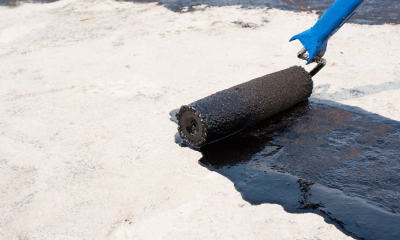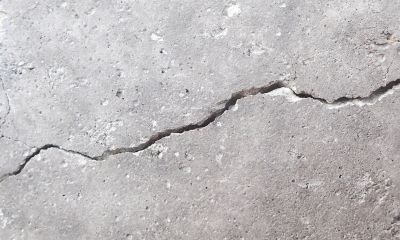A starter guide to fireproofing concrete buildings in alphabetical order – from Building Regulations to flammable materials and intumescent coatings
A beginner’s guide to fireproofing concrete buildings
Whether an existing structure or a new build, a factory or an office block, a private site or a public one – buildings have mandatory fire rules, regulations, and procedures that must be abided by. Some are completed at the design phase, some at the construction phase, and others under the responsibility of the building’s owner once the site has been fully built. Here is our starter guide to fireproofing concrete buildings – it’s a non-exhaustive list of what fireproofing and fire protection involve. Remember, you can call our expert team on 01482 425250 at any time if you’d like further information!
The A-Z of fireproofing concrete buildings
A – is for alarm systems Ensure you have an adequate number of fire alarms, that they undergo regular testing, and are working.
B – is for Building Regulations These are mandatory, statutory safety regulations for buildings in the UK. You can view the UK Building Regulations here, or skip to the end of this guide and continue reading about them in our other fire safety blogs.
C – is for cavity wall insulation A popular, eco-friendly, and energy-efficient way of keeping the heat in concrete buildings. Cavity wall insulation also happens to be highly fire-resistant! See `F – flammable materials & fire-resistant materials` for more on this point.
D – is for damages Aside from keeping individuals safe in the event of a fire, the other core reason we put so much effort into fire protection measures is, of course, to prevent severe damage to the building or structure. Although concrete is extremely tough and naturally fire-resistant (as we continually emphasise), it is not indestructible!
E – is for evacuation plan Fire Emergency Evacuation Plans (FEEPs) are as old as time. We bet you can remember lining up in the playground during a practice fire alarm, right? Well, having a designated meeting point is all part of a building or structure’s evacuation plan, along with dedicating a fire marshal to checking everybody gets out safe and is present. There is a great resource on the .gov.uk website.
F – is for flammable materials & fire-resistant materials Nowadays, construction materials have a fire safety rating. This means they undergo rigorous testing in an environment akin to a blazing fire, and they are tested on how they resist the flames and extreme temperatures. For example, wood is a flammable, combustible material with a poor fire safety rating, whereas concrete has the highest fire safety rating possible (A1) and is naturally highly resistant to fire. What’s more, UK Building Regulations state that certain rules must be followed when applying flammable materials to buildings and structures (if it’s necessary they are used), such as keeping wood away from entrances and exits.
G – is for Grenfell The Grenfell Tower disaster back in June 2017 is a devastating prime example of why fireproofing buildings (and checking the preventative measures are still adequate) is so, SO important. In the case of Grenfell, it was thought that flammable cladding was used on the 24-storey building, enabling the fire to further ignite – causing 72 deaths and destroying the tower block. To read more about Grenfell’s fire protection measures, skip to our blog.
H – is for heat-producing appliances Ovens, open fires, hand dryers, boilers… buildings are installed with a wealth of heat-producing appliances, all of which are potential fire hazards. Remember to get your appliances checked on a routine basis to reduce your risk of fire, especially those that emit gases.
I – is for intumescent coatings…or intumescent paints! These coatings are made to provide an extra layer between the fire and the interiors of a building or structure, prolonging the length of time fire exposure can happen before damage occurs. To learn more about intumescent coatings and if they are suitable for your building or structure, call our expert team on 01482 425250 or fill in a contact form today.
J – is for judging contractors based on their previous work Looking for a contractor to review your fire safety precautions and procedures, or starting a new project and need specialist advice? One of the best ways to check if a contractor is worth their salt is by checking out previous and existing projects they’ve been involved in. Browse our projects here
K – is for keep clear Here’s one you’re bound to know! Usually displayed in blue and white signage – fire exits, escapes, and doors are required to have a keep clear message. Your building or structure must abide by this message at all times, whether works are being done or the building is back in function.
L – is for local fire & rescue authorities This one needs no introduction. Suspect a fire? Raise the alarm is it’s safe to do so, stick to your Fire Emergency Evacuation Plan (FEEP), and call 999 to alert your local fire & rescue team.
M – is for moisture content If concrete has not dried out fully during construction, it can hold moisture and be susceptible to `spalling`. To lower the risk of fire damage to concrete, specialists need to ensure there is no risk of moisture being trapped inside walls, ceilings, beams, etc.
N – is for new builds Much like existing buildings, new builds must follow the UK government’s guidelines on fire safety, which are listed under UK Building Regulations.
O – is for on-site safety Meaning everything is in place to ensure your employees and anybody else entering your building or structure is safe and protected from risks of fire. If you’re unsure whether your safety measures are up to scratch, you can ask an expert to visit you and complete a site analysis. Book your free feasibility study.
P – is for Passive Fire Protection (PFP) Uses a variety of fireproofing systems to ensure the building or structure doesn’t collapse in the event of a fire. Get in touch with our team today to discuss our range of PFP fireproofing systems.
Q – is for question your fire safety measures Not sure if your fire alarm system is working? Worried about a fire door that consistently swings open? Don’t wait to get these things checked out! The outbreak of fire is unpredictable and taking preventative measures only lowers the risk of it happening, so we urge you to reach out for a site inspection if aspects of your building’s fire safety concerns you. You can book a free feasibility study with our expert team here.
R – is for robust fire doors An essential part of your fire protection plan.
S – is for structural steel fireproofing A specialty of ours! Commercial buildings need to keep their shape for at least 2 hours in a fire, which is theoretically enough time for its inhabitants to exit the building safely.
T – is for testing Alarms, sprinkler systems, fire doors, extinguishers, safety equipment – it all needs extensive (and regular!) testing to ensure it is fit for purpose.
U – is for under control from preventative measures to quelling the fire if one should start, keeping everything under control is critical.
V – is for visiting your site for a free cost analysis Our expert team is ready to visit your site and complete a free cost analysis, giving you an approximate quote of how much your new fireproofing measures will likely cost. Call us to book your free cost analysis and feasibility study today: 01482 425250.
W – is for water sprinkler systems Another essential fire protection measure – especially for tall tower blocks. If your building or structure doesn’t have a sprinkler system, it’s worth checking if you’re required to install one.
Y – is for Yorkshire CCUK has a specialist team located in Yorkshire and ready to visit your site, free of charge, to analyse your current fire protection measures. Call us to book your free feasibility study and cost analysis today: 01482 425250
Z – is for Zoom call If you’d like further information about how to fireproof your building or update your fire protection measures, book a free Zoom call with our expert team today. Close by to Hull and the Humber? Why not pop in for a coffee & catch-up instead? Book a coffee & catchup.
Suggested reading for you based on `fireproofing concrete buildings`
Your Guide to Fire Protection Coatings for Concrete
Protecting Buildings From Fire: A Guide to Fireproofing Concrete




